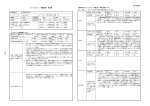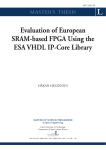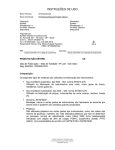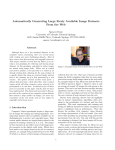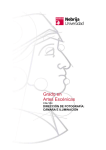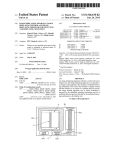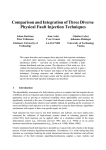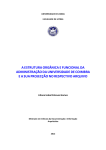Download InFault - ESA Microelectronics Section
Transcript
Smart Behavioral Netlist Simulation for SEU Protection Verification Simon Schulz, Giovanni Beltrame, David Merodio-Codinachs Abstract— This paper presents a novel approach to verify Single-Event-Upset (SEU) protection based on smart behavioral simulation. Our analysis does not require a testbench and can perform full, exhaustive coverage within less than an hour for typical designs. Index Terms— Triplication verification, SEU Analysis, Behavioral simulation, netlist conversion, Graph Representation, I. I NTRODUCTION Hardening circuits against radiation effects that occur in space is a complex task. Without being protected by the earth’s magnetic field, integrated circuits are exposed to ionizing radiation, which can disrupt the circuits’ behavior. This paper focuses on the so called Single-Event-Upset (SEU) effects, or soft errors, usually caused by the transit of a single ionizing particle through the chip. This particle can upset storage elements and change their value from zero to one or vice versa by modifying the charge at a storage node [1]. Protection against this effect can be done in several ways, and in particular this work concentrates on the protection based on triple modular redundancy (TMR), consisting in the triplication of every storage element combined with majority voting logic [2]. This protection can be either inserted during high level design [3] or at a later stage by automatic netlist modification. Typically, after a new ASIC is produced for the space market, it undergoes a strict test campaign, including costly and time consuming radiation tests using particle accelerators. When a problem arises during a radiation test campaign, it is already too late; the first prototype ASICs have been manufactured and the whole fabrication process needs to be rerun after fixing the netlist. It is desireable to detect any problems before fabrication, therefore several software [4]–[7] and hardware-based [8] tools for fault injection and verification were proposed in the past. However, such tools either do not provide full coverage or require extremely long simulation and/or execution times. This paper presents a novel way to analyze the SEU sensitivity of a given netlist by taking a gate-level netlist as input and executing a smart behavioral simulation, and verifying the correctness of the implemented countermeasures against SEUs. To perform a fast analysis, we use a divide et impera approach, transforming the input netlist into a directed graph representation and analyzing smaller subgraphs. Results show that verifying TMR on a 40k gates netlist is possible within around half a hour on a standard PC. Another advantage The authors are with the European Space Agency, ESTEC, 2200 AG Noordwijk, The Netherlands (phone: +31 71 565 8357, fax: +31 71 565 6791, e-mail: [email protected]). over other traditional simulation/verification methods is that our approach does not rely on a testbench, allowing a full coverage test. This paper is organized as follows: previous works on the subject are introduced in Section II; Section III present the base idea of the proposed algorithms; Section IV details the algorithm together with necessary definitions, its implementation and its complexity; experimental results are shown in Section V, and Section VI draws some concluding remarks. II. P REVIOUS WORK In the past, several different approaches have been proposed for design verification against soft errors. These approaches can be divided in two kinds: fault injection simulation and formal verification. Fault injection simulators run a given testbench on the design under test (DUT), flipping either randomly or specifically targeted bits. The outputs of the DUT are then compared with a golden model running the same testbench, and discrepancies are reported. Fault injection simulators come in two different flavors: on the one side there are software-based simulators like MEFISTO-L [5] or SST [6] (which is based on Modelsim), that allow full observability and control of the simulated netlist. These tools are marred by extremely slow low-level simulation, requiring hours or days of simulation, without any guarantee of full coverage. On the other hand some tools use special hardware to speed up the simulation cycle, such as FTUnshades [8], which uses partial reconfiguration of an FPGA to introduce single bit-flips (simulating SEUs) in a fast manner without requiring modifications of the DUT. Although this provides a consistent speedup compared to the software based approach, it is still infeasible to run full verification of a given design, which requires the injection of bit flips in all possible Flip-Flops (FFs) at any possible time during the simulation. In addition, the results of these approaches strongly depend on the testbench used. Formal verification against soft-errors was introduced by [9]: the idea is to merge a formal model of the DUT with a soft error model, proving a given set of properties on the merged model. This requires a formal model of the DUT and a complete and exhaustive set of formally defined properties to be proven. In other words, the main issue of this formal approach is that the coverage is as good as the definition of such properties. This work tries to overcome these limitations and provide full SEU protection verification of a TMR-based DUT with reasonable simulation time. The idea presented in this paper can be classified as a fault-injection simulation, but follows a different approach with respect to previous work: instead of trying to simulate the whole circuit at once and doing a timing accurate simulation we focus on the behavioral simulation of small submodules, extracted by automatic analysis of the DUT internal structure, with the specific goal of detecting any FF/voter pairs that are susceptible to SEUs. III. P ROPOSED A PPROACH The starting point of our analysis is a radiation hardened circuit, protected by triplication and voting (TMR [2]). The objective of this analysis is finding any FFs that are not adequately protected. Starting from a given design with n FFs, a naive testing approach for SEU-susceptible FFs would require testing all 2n possible configurations, for all of the m time instants of a given testbench. This would lead to an impractically long simulation time as typical as systems consist of several thousand FFs. Our approach uses the properties of the DUT in order to split the whole system into smaller submodules. Those small submodules can be analyzed independently, allowing a full test to be carried out in a reasonable timeframe. The DUT is initially converted into a directed graph representation, based on a post-synthesis gate-level netlist (e.g. an EDIF file or a verilog netlist). This graph representation consists of nodes (modeling logic gates) and edges describing wires or interconnections between the gates. Using this representation, each FF i in the DUT is selected, and the subgraph of FFs connected to i’s input is calculated. Then, all valid start configurations (see Definition 6) for the FFs belonging to this subgraph are calculated, simulating all possible injections on the generated subgraph. For every injection, the result is compared to fault-free simulation: if the results differ, the FF i is marked as susceptible to SEUs. We implemented a prototype of the algorithm relying on some assumptions: the whole circuit is driven by only one clock and there are no loops inside logic without a storage element being involved. Furthermore, it is assumed that there are no signal conflicts inside the netlist (i.e., two-valued logic) and that there are no timing violations. Finally, we assume that all FFs have one data input, one clock source, and all the triplets have separate reset and set lines. For the sake of simplicity, Single Event Effects (SEEs) on the reset and set lines are not considered, but they could be analyzed in a similar way. IV. M ATHEMATICAL MODEL To convert the netlist describing the circuit into a graph, we need to introduce a special directed graph structure. The nodes of this graph have indexed inputs and are associated with a logic function and a value, as outlined in the following. We assume without loss of generality that every gate has just one output. Gates that have n 6= 1 outputs are converted into n nodes having the same inputs, each representing one output. Taking this into account the netlist can be easily converted into a directed graph structure Definition 1: A circuit graph G is defined as a tuple {V, E, S, F }, where: • V is a set of nodes (representing logic gates) • E ⊆ V × V × N0 is a set of edges (representing interconnection wires) • S ⊆ V × {0, 1} is a set of values (representing the node values) • F ⊆ V × T is the set of logic functions associated with each node, where T is the set of computable boolean functions Every node v ∈ V has 1 output and num inputs(v) ⊆ N0 inputs. The set of valid input indices for a node v ∈ V is given by Nv = {1, ..., num inputs(v)} An edge e = (x, y, i) ∈ E with x, y ∈ V and i ∈ Ny represents a connection from node x to the input i of node y. Assuming that the input circuit is free of driving conflicts, the circuit graph fullfills the property: ∀v, w, x ∈ V, ∀i ∈ Nv : v 6= w ∧ (w, x, i) ∈ E =⇒ (v, x, i) 6∈ E which means that any given input of a node is connected to a single node output. We also assume that there are no unconnected inputs in the circuit, which translates to the property: ∀x ∈ V, ∀i ∈ Nx , ∃w ∈ V : (w, x, i) ∈ E (1) To describe the algorithm, we need to define predicates that represent node properties. Definition 2: The set of direct predecessors of node x, i.e. the set of nodes with a direct connection from their output to one of x inputs is defined as: pre(x) = {w | ∃i ∈ Nx : (w, x, i) ∈ E} Definition 3: Let us define the predicate is f f for a given node x ∈ V , which determines if x represents a FF: true if x ∈ V is a FF or in-/output node is f f (x) = f alse else For the sake of simplicity, top-level in-/outputs are considered as FFs with no inputs. The set of nodes that represent FFs is: VF F = {x | ∀x ∈ V, is f f (x)} Definition 4: We define the set of nodes which are directly and indirectly connected to the inputs of a given node x ∈ V as the smallest set pre f f s(x) for which the following properties hold ∀w ∈ pre(x): is f f (w) =⇒ w ∈ pre f f s(x) ¬is f f (w) ∧ v ∈ pre f f s(w) =⇒ v ∈ pre f f s(x) Having defined the FFs as just having one input (see section III) we can define the driving node for a given FF as Definition 5: A driver for FF x ∈ VF F is defined as: driver(x) = {y | (y, x, 1) ∈ E} Finally, we need the operators to compute the values associated with each node: Definition 6: The value of a node x ∈ V is given by the eval operator, defined as: evalF F (x) if x ∈ VF F eval(x) = evalL (x) else where evalF F returns the value stored in FF x: input : a node x ∈ V 1 2 3 4 5 6 7 evalF F (x) = {a | (x, a) ∈ S} 8 and evalL computes the value of logic (i.e., non FF) nodes, which depends on the node input values: 10 9 11 evalL (x) ={f (eval(y1 ), ..., eval(yn )) 12 | (x, f ) ∈ F, yi ∈ pre(x)} 13 14 We also define the configuration of a set of FFs xi ∈ VF F as conf ig(x1 , ..., xn ) = (eval(x1 ), ..., eval(xn )) 15 16 A configuration conf ig(x1 , ..., xn ) is defined as valid when ∀x1 , ..., xn ∈ VF F , ∀i ∈ Nxi , ∀j ∈ Nxj : driver(xi ) = driver(xj ) =⇒ eval(xi ) = eval(xj ) which means that if two FF have the same driver, they must share the same value, ruling out impossible FF values. A. Simulation Algorithm As stated in section III the input of our algorithm is a radiation hardened circuit protected by triplication. Before starting the analysis, we optimize our description by removing for us unnecessary elements as one-to-one buffer gates. This is done during netlist parsing or by graph inspection. As such buffers do not manipulate the logic value of a signal; it is easy to see that the logic functions are not changed when those buffers are removed. If the TMR implementation were working correctly, a single bit-flip in one FF should not cause another FF to change its value. If a faulty triplicated FF/voter pair exists, there is at least one FF whose value can be changed by a single bit-flip in another FF. This is true only if the configuration before the bit-flip injection was a valid configuration. The algorithm tries to find such FFs, and if none is found, TMR is correctly implemented. The main idea of the test algorithm is that complexity can be reduced by checking only small submodules instead of the whole system. In order to do this, we observer that a bit-flip in one FF can only distribute to the next FF during the current clock cycle. It is then possible to determine the set of all FFs which could potentially influence a given FF x ∈ VF F , i.e. pre f f s(x). The algorithm takes each FF xi and determines the set of FF that are connected to it via logic only (no memory elements), and tests every possible bit flip for every possible valid configuration. If any of these bit flips is able to change xi stored value, then the algorithm detected a fault in the TMR implementation. More formally, Algorithm 1 describes this behavior in pseudocode (where abort interrupts execution (y1 , ..., yk ) ←pre ffs(x); foreach valid c ∈ config(y1 , ..., yk ) do for i ← 1 to k do value(yi )← ci ; end init value ← evalF F (x); foreach 1-bit mutation c0 of c do for i ← 1 to k do value(yi )← c0i ; end mut value ← eval(x); if mut value 6= init value then abort(FF x sensitive to SEUs); end end end Algorithm 1: analyze algorithm and shows a message to the user). As the analysis has to be performed for all x ∈ VF F , simulation times might be excessively long. To reduce runtime, this algorithm has to be extended to handle large sets of driving FFs (y1 , ..., yk ). If the number of elements t = |pre f f s(x)| in such a set exceeds a given threshold, the graph will be split into smaller subgraphs until the threshold is reached, as outlined by Algorithm 2. input : a node x ∈ V 1 2 3 4 5 6 7 if |pre f f s(x)| < threshold then analyze(x); else foreach node y ∈ pre(x) do split analyze(x); end end Algorithm 2: split analyze algorithm Since we consider post-synthesis netlists, it is possible that voting logic has been embedded into other logic elements during optimization. This means that splitting the graph might result in some false positives (of faulty TMR implementation) because the splitting could have destroyed the voting logic. However, choosing the threshold as a trade-off between runtime and the risk of false positives gives good results in our experiments. It is worth noting that this will never hide any SEU sensitive parts: if TMR is not properly implemented, it will be detected. In case the algorithm reports a SEUsensitive FF, testing with a higher threshold value (or manual inspection) can identify if it represents a false positive. B. Algorithm complexity analysis Given m = |V | and n = |VF F |, the total number of gates and FFs, respectively, an exhaustive search would result in 2n possible FF configurations to test, requiring O(m2n ) node evaluations. Determining a subgraph to be analyzed for every node x ∈ VF F , gives n subgraphs to verify. Using the properties presented in section IV-A, the algorithm has to check px = |pre f f s(x)| FFs, with typical designs showing that in general px n. As described in section IV-A, the algorithm limits px to a given threshold t by splitting the graph into subgraphs. Therefore there are less than 2t valid configurations we have to evaluate for every subgraph (assuming FF triplication, we t expect less than 2 3 valid configurations). As we are testing one bit-flip at a time, we need to perform t injections on every valid configuration. Obviously, the number of subgraphs obtained after splitting and their sizes cannot exceed the total number of gates m, resulting in less than n · 2t · t · m subgraph evaluations. Overall, the algorithm performs O(nm2 ) node evaluations, showing polynomial behavior and outperforming other exponential verification methods. V. E XPERIMENTAL RESULTS The algorithm presented in Section IV-A was implemented as a C++ program called InFault (Intelligent Fault analysis). In order to convert a given netlist into a graph representation a custom parser and converter was written. Currently the program supports Xilinx EDIF files and Verilog gate-level netlist files. The parser can be easily extended to support other input files. The graph itself was implemented in a custom linked graph structure, using pointers whenever possible to maximize speed. For every gate in the netlist library, a node class is built using a Perl script using a Verilog ASIC library description as input. The library for the Xilinx EDIF was written manually and implements only a small subset of nodes necessary for the design in our tests. In order to ease debugging, every node also stores some additional data like the name of the gate in the original netlist. The implementation was tested on netlists describing submodules of a radiation hardened LEON2-FT processor [10] on a normal desktop PC (2.66GHz Intel Core Duo) with a memory usage smaller than 100MB. Table I shows the results of such tests, and compares the runtime with the expected runtime of FT-Unshades [8]. The runtime for the FT-Unshades test was calculated based on ideal assumptions, using a testbench lasting 200000 clock cycles and injecting bitflips in all FFs, with each injection requiring 5ms. It is worth noting that this small number of simulation clock cycles cannot cover all possible internal substates of the DUT, therefore resulting in a non exhaustive test. A testbench that covers all internal substates is hard or even impossible to design, and the simulation time would be so high to render the analysis impractical. Compared with the FT-Unshades toolchain, which introduces a consistent speedup with respect to PC based simulators, our approach is several orders of magnitude faster. TABLE I RUNTIME COMPARISON BETWEEN FT-U NSHADES AND I N FAULT Testcase resetgen pci mas pci tar dsu mctrl fpu amod iu pci # of gatesa 648 14379 13768 29139 35357 66967 87193 147894 190987 # of FFs 30 453 546 876 1251 1437 3303 4224 7974 FT-Ub 8h 5d 5h 6d 7h 10d 3h 14d 11h 16d 15h 38d 5h 48d 21h 92d 7h Infaultc <1m 2m 2m 15m 15m 1h 52m 59m 2h 1m 32m a Gatecount after mapping library to standard logic cells exhaustive c exhaustive, full coverage b not VI. C ONCLUSIONS & F UTURE WORK In this work we presented an algorithm for detecting TMR implementation problems in a given netlist before ASIC manufacture. The proposed algorithm does not require a testbench and can perform exhaustive verification of production-ready netlists, like the LEON2-FT processor presented in this work, in reasonable time (less then 1 hour). To the best of the authors’ knowledge, no other approach provides this kind of performance. Future work includes replacing the actual simulation/injection step with the identification of triplets followed by formal verification of the correct propagation of flip-flop values through the voting logic, and the use of hardwareaccelerated fault-injectors. R EFERENCES [1] George C. Messenger and Milton S. Ash, The effects of radiation on electronic systems, 2nd ed. Van Nostrand Rinhold, 1986. [2] C. Carmichael, XAPP197: Triple module redundancy design techniques for Virtex FPGAs, Xilinx Inc., July 2006. [Online]. Available: http://www.xilinx.com/support/documentation/ application notes/xapp216.p%df [3] Sandi Habinc, “Functional Triple Modular Redundancy,” Gaisler Research, Tech. Rep., 2002. [Online]. Available: http://www.gaisler. com/doc/fpga 003 01-0-2.pdf [4] G. Kanawati and J. Abraham, “Ferrari: a flexible software-based fault and error injection system,” Computers, IEEE Transactions on, vol. 44, pp. 248–260, 1995. [5] J. Bou, P. Ptillon, and Y. Crouzet, “Mefisto-l: A vhdl-based fault injection tool for the experimental assessment of fault tolerance.” IEEE Computer Society, 1998, p. 168. [6] J. A. Maestro, SST 2.0: User Manual, Universidad Antonio de Nebrija, November 2006. [Online]. Available: http://www.nebrija.es/∼jmaestro/ esa/docs/SST-UserManual2-0.pdf [7] K. K. Goswami, R. K. Iyer, and L. Young, “Depend: A simulation-based environment for system level dependability analysis,” IEEE Transactions on Computers, vol. 46, no. 1, pp. 60–74, 1997. [8] M. Aguirre, J.N. Tombs, V. Baena-Lecuyer, F. Muñoz, A. Torralba, A. Fernández-León, and F. Tortosa-López, “FT-UNSHADES: A new System for Seu Injection, analysis and diagnostics over post synthesis netlist,” MAPLD’2005, Nasa Military and Aerospace Programmable Logic Devices, Sept. 2005. [9] S. A. Seshia, W. Li, and S. Mitra, “Verification-guided soft error resilience,” in Proc. Design Automation and Test in Europe (DATE), April 2007. [10] J. Gaisler, “The LEON2 IEEE-1754 (SPARC V8) Processor,” Gaisler Research, 2003. [Online]. Available: http://www.gaisler.com




